Quick Summary:
Understanding the subtle differences and similarities between Edge computing vs Cloud Computing and figuring out how they can work together to fuel your business operations and products can help you gain a massive boost in terms of growth, profitability and getting ready for the future of the digital era. Here’s everything you need to know about the cloud and edge computing.
Cloud computing was all the noise until recently, and as soon as businesses started grasping this concept, edge computing gained a sudden surge and piqued everyone’s curiosity. Now the urge to compare cloud vs edge computing is understandable, but long story short, they are not alternatives to each other. Rather cloud computing and edge computing can be leveraged together to drive strategic business-driven solutions. Having said this, their similarities and differences are worth noting to make an informed decision on when to choose edge over cloud and cloud over the edge.
Let’s start by understanding both concepts first:
What is meant by Edge Computing?
Edge computing runs on the fundamental concept of processing data closer to the location where it is required/generated. Why is this important? Being in physical proximity to the workstation, your system processes can run at higher speeds, process more volume of requests and deliver better results in real-time.

This is where the concept derives its name, too, placing the computing resources at the edge of the network rather than in a centralized cloud computing platform that could be set up miles away from your existing system. The proximity also ensures reduced latency and improved computational power.
Types of Edge Computing
Edge computing works with many different devices, often known as ‘Edge devices’ that contribute to the overall edge computing process. Here are some of the top edge computing types you should know about:
| Type of Edge Computing | Purpose | Components of Edge Computing |
| On Premise Edge | Computing edge resources at the enterprise premise help localize data processing, reducing the time to process data significantly. | Network Gateways, Universal Customer Premise Equipment |
| IoT Edge | Placed never IoT devices, receives the data sent from such devices, processes it, and makes decisions quickly due to its high computational capabilities. | Mobile Devices, Factory Sensors, Connected Cars, Retail Shops, Cameras, Parking Meters |
| Access Edge | All infrastructure necessary for deploying and managing software Radio Access Network functions is collectively known as Access Edge. | Open RAN, Vran, O-RAN |
| Network Edge | All data from various IoT edge devices, On-premise edge devices and Access edge are aggregated before connecting the centralized data hub. This is known as Near Edge or Network Edge. | Regional Data Centres, Next Generational Central Office, Wireline Fixed Access |

Edge Computing vs Fog Computing – What is Fog Computing?
You might have heard this word tossed around recently – ‘Fog Computing’ and wondered what the buzz is all about. Well, many people believe there are differences between Fog and Edge computing, while others use the term interchangeably. So it can be considered a type of Edge Computing but is slightly different.
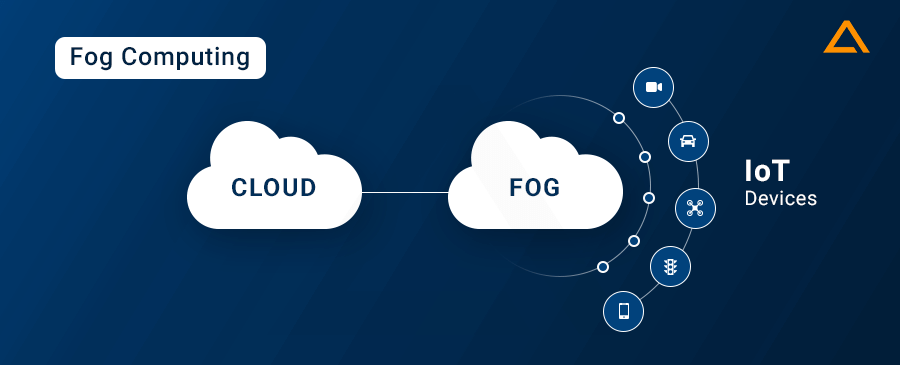
Fog Computing is a decentralized computing method where all assets, such as storage, computing, apps, data and others, are located between the cloud and data source. Like edge computing, Fog brings the power of the cloud’s computational capabilities closer to the data processes. This term is believed to be initially tossed by Cisco, and you can read more about it on their official What is Edge Computing blog.
Fog Computing brings strong analytical capabilities to the edge of your computing setup. At the same time, the cloud retains the heavy-lifting job of long-term analytics and deals with permanent data that doesn’t need to be accessed frequently.
Benefits of Edge over Cloud Computing
Edge Computing has certain advantages over traditional cloud computing in certain use cases. Due to how it’s designed and functions, it helps you achieve certain results that aren’t as easy to achieve with cloud computing. Here are the advantages of Edge Computing over Cloud Computing:
- Efficient Data Management
- Reliable and uninterrupted connection
- Better security practices with economic connectivity costs
- Interoperability between modern and legal devices
- Better Reliability since data is distributed and not stored in a centralized location
- Security and compliance adherence
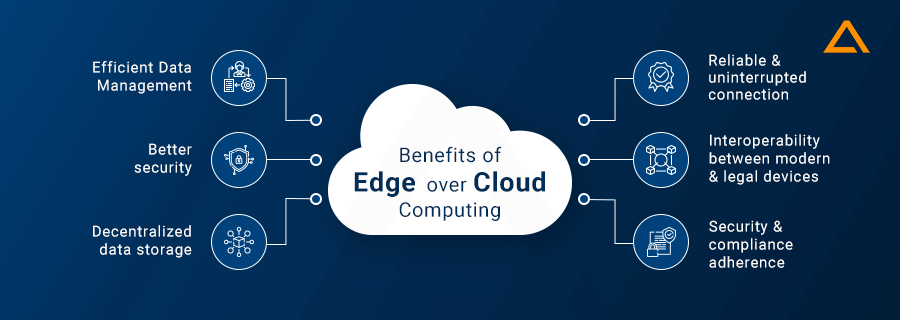
Limitations of Edge Computing to Cloud Computing
Although Edge Computing brings considerable benefits to the table, it also isn’t without its limitations. Here are certain disadvantages of Edge Computing you should know about:
- Low Processing Power
- It only covers the local area
- Insufficient storage
- Different requirements require different specs
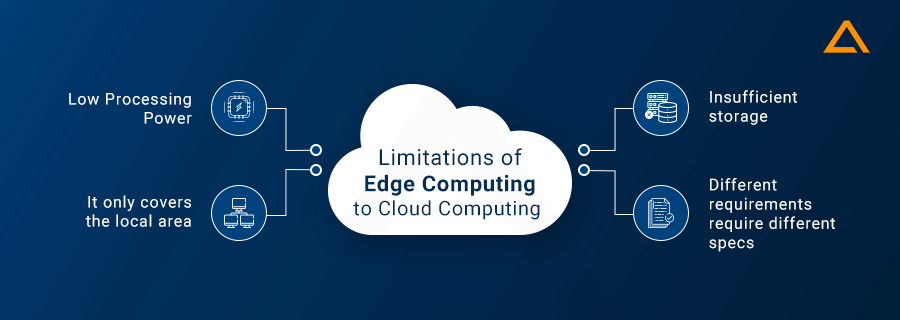
What is meant by Cloud Computing?
Cloud computing is managing and processing computing services such as databases, storage, servers, software and more over the internet. This allows flexible access to all your IT assets on a pay-as-you-go pricing model.

Cloud computing eliminates the need to own, buy and maintain physical servers, data centers and more, saving you the huge infrastructure cost of hosting and maintaining such heavy machinery. You can leverage the cloud services of some of the most popular companies, such as Google Cloud Services, Microsoft Azure and Amazon Web Services.
Types of Cloud Computing
Fundamentally, there are three types of cloud computing methods – SaaS, PaaS, and IaaS. The type of cloud computing services is categorized based on the degree of management it covers for you and other specifications. To enhance your grasp of these concepts, you might consider enlisting the expertise of Hire SaaS Developers. Here is a brief explanation of different cloud computing types you should know about:
| Type of Cloud Computing | Purpose | Examples |
| SaaS Software as a Service |
Allows end users to connect and use cloud-based apps over private/public networks such as the internet. It is a comprehensive software solution with a pay-as-you-go pricing model from any preferred cloud service provider. | Hubspot, Salesforce, Slack, Buffer |
| PaaS Platform as a Service |
Provides a holistic development and deployment environment using the cloud, giving resources for building basic cloud apps to enterprise-grade cloud apps. | Google App Engine, AWS Elastic Beanstalk, Heroku |
| IaaS Infrastructure as a Service |
Offers the needed storage, networking and computational resources on a pay-as-you-go basis. | Microsoft Azure, Google Computing Engine, Rackspace |

Also Read: IaaS vs PaaS vs SaaS
Edge Deployment vs Cloud Deployment – Cloud Deployment Models
One good thing about cloud computing is it can be accustomed to your requirements. However, to pick the right cloud computing model for your business, you need to understand them in greater detail to see which is more suitable for your requirements. Here are the various cloud deployment models you can choose from:

Private Cloud
Ideal for: Cost Efficiency, Greater Control
The private cloud computing model is when you integrate private cloud services into your business processes and manage them in-house. It is a dedicated computing model where all the infrastructure is dedicated to a single user/organization. You can host a private cloud on-prem or externally. Private cloud computing is also ideal when you need to set up your cloud computing with specific customizations and dynamic requirements. However, if your business is looking to expand rapidly, the private cloud can cause hindrance to that since it isn’t very flexible on scalability and requires frequent maintenance.
Public Cloud
Ideal for: Minimal investment, Low-Security Concerns, Testing
If you have growing cloud computing needs and security isn’t your priority, you could opt for a public cloud computing deployment model. You could leverage the services of a third-party cloud service provider like a Google Cloud Platform Consulting Company for computing, virtualization and other such services. However, beware that since it’s a shared computing model available to the public, there can be outages and malfunctions and chances of cyber-attacks also increase significantly.
Community Cloud
Ideal for: Low Investment, Industry-Grade Setup
Community cloud computing may sound and feel familiar to public cloud computing; however, it’s slightly different. It only allows access to a selected group of users with similar objectives and requirements. You can manage a community cloud internally or via a third-party service provider.
Benefits of Cloud over Edge Computing
Cloud computing has some major benefits that edge computing can’t provide. If you are looking for these specific benefits, you should opt for cloud computing solutions:
- Easy to set up and use
- Efficient and hassle-free management
- Massive storage capacity
- Wider area coverage
- Computational efficiency
- Robust processing

Limitations of Cloud over Edge Computing
The cloud doesn’t perform at par with edge computing for certain aspects of computing requirements. Here are some of the limitations of cloud computing to edge computing:
- Privacy and Sensitive Data Risk
- Higher bandwidth costs
- Latency issues
- Service provider reliability
- Downtime if the internet isn’t available

Edge vs Cloud Computing – Which is right for me?
Choosing between edge and cloud computing can be difficult since they are pretty technical concepts for non-IT firms or even firms with some technical expertise. Here are certain questions that can help you choose the right computing platform for you:
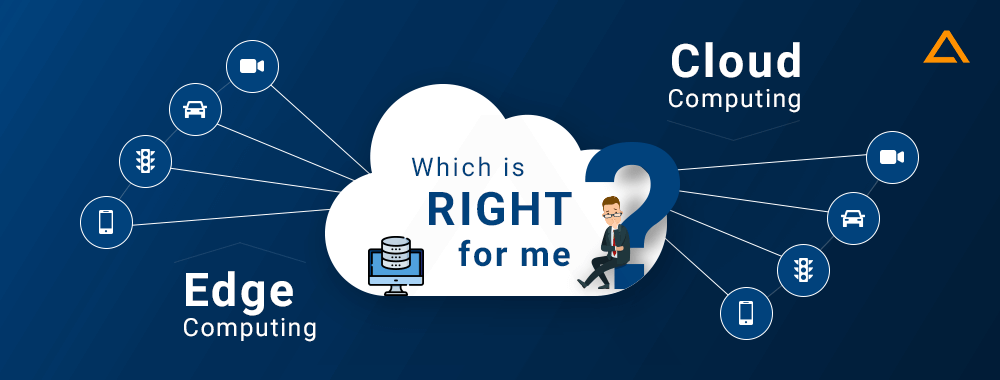
Data Sensitivity – What is the nature of your collected data?
How sensitive is the data you need to process or collect? Deal with customers private information or any other sensitive data, such as banking or financial information. Edge computing will provide better Reliability and security when we think about the risk of data exposure. If you store all your user’s data at a centralized cloud platform, it becomes more susceptible to unauthorized attacks and data breaches.
IoT Algorithm – Mature vs Young
Edge computing can be better if you work with an IoT environment and the processing method is fairly straightforward and self-sufficient from users’ devices. However, cloud computing can be a better alternative if your app needs complex logic handling and is in the initial stages of development or refinement.
Storing data at a centralized location and experimenting with various data processing approaches can give you more room and freedom to figure out which solution works best for your project. Also, since the cloud provides centralized updates, you could solve any algorithm issues OTA making maintenance seamless.
Scalability – What is your data size and type?
Almost all solutions rely on some data. However, there’s a difference between data-centric businesses that churn out numbers and processes new data regularly versus businesses that only rely on data for reporting and tracking requirements.
If your project requires processing heavy data files daily, cloud services can be a better choice for you. This is because they have impressive computational capabilities with flexible pay-as-you-go pricing models. Hence it is easy to scale your operations over time with cloud computing.
Urgency – How quickly do you need the output?
Depending on what kind of project you are building, your response time priority will change drastically. If your primary concern or target is providing real-time insights based on inputs, the edge is a clear winner for you.
Cloud computing works on the internet, and while internet speeds have increased dramatically, there can still be delays or faults in cloud processing, especially if you experience an unexpected server downtime. However, since edge computing relies on edge devices closer to the project and experiences lower latency, they are a more reliable choice for projects needing real-time outputs.
Edge Computing vs Cloud – Differences
Now that we understand the basics of cloud and edge computing let’s focus on the differences between Cloud computing vs Edge computing.
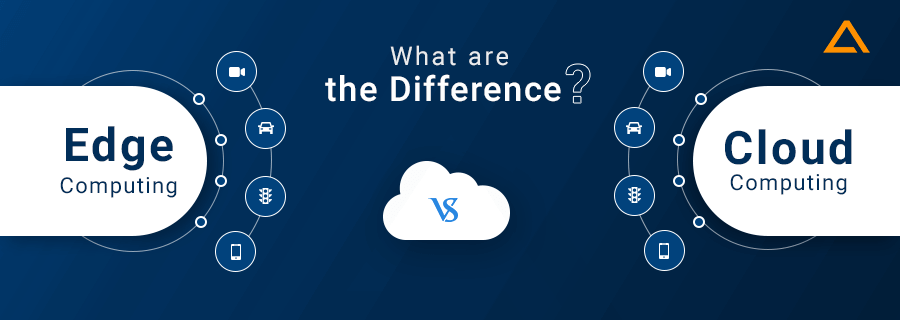
These differences will help us understand which of the two platforms will be more suitable for your business requirements:
| Differentiator | Edge Computing | Cloud Computing |
| Computing Power | Limited | High |
| Data Control | Decentralized, secure | Centralized cloud, vulnerable |
| Best For | Companies needing bandwidth and real-time interaction | Companies needing heavy data processing from structured, semi-structured and unstructured data sets |
| Operates On | Edge Devices nearby users | Cloud services like Amazon Web Services, Google Cloud Platform and Microsoft Azure |
| Data Distribution | Multiple local locations | One centralized location |
| Cost Effectiveness | Lesser value for money | Optimal |
| Privacy | Better privacy | Prone to hacking |
| Reliability | Not dependent on the internet | Dependent entirely on the internet |
| Scalability | Difficult | Easy to scale |
| Proximity | Closer to the system, at the edge | Far from the edge |
| Data Analysis | Real-time, quick decision making | Permanent, lesser focus on the urgency |
| Interoperability | Lower | Higher |
| Latency | Low | Higher |
| Bandwidth Requirement | Huge | Significantly Low |
Edge vs Cloud #1 – Computational Power and Focus
The main agenda of Edge computing is to process real-time data and communicate between different devices in an environment. In contrast, cloud computing focuses on processing chunks of data in structured, unstructured or any other format. Data is processed once at a time in cloud computing and not in real time.
Cloud vs Edge #2 – User Data Control
Both Edge and Cloud approach user data control differently. All data in Cloud computing is hosted in a centralized cloud server, and you are most likely to hire a third-party cloud service provider to set up your cloud computing platform.
This means all your app-related and user-sensitive data will get stored on the cloud, and you won’t have any direct control over it. In contrast, Edge computing brings the data computation benefits closer to your devices, eliminating the need to uplink data to the cloud.
Edge vs Cloud #3 – Data Distribution and Ideal Use Case
Edge computing is a decentralized computing platform, and by leveraging IoT, it distributes the computing infrastructure to edge devices with higher specs for real-time computational requirements. Most information processed by IoT devices, such as sensors, mobile devices and others, requires instant processing via real-time data analysis. Hence Edge computing becomes an ideal fit for such situations. One instance of edge computing can be autonomous vehicles.
Cloud computing is a centralized computing platform where the data is stored in a centralized far-off location from the system devices. It covers a wider range of devices and pulls higher computational tasks. However, it doesn’t focus or perform well with real-time data processing requirements.
Cloud vs Edge #4 – Privacy and Data Security
The increased IoT devices such as mobiles, network points and others have provided much-needed ease of setting up an environment; however, it has also raised concerns about environmental security and possible exploitations.
Hence companies that deal with sensitive user data need to be very careful of their security measures and how they handle their user data. Edge computing is a great option for securing sensitive information via encrypted tunnels, firewalls and access control. Some also come with features such as early threat detection, managing vulnerabilities, and more.
Cloud computing is more prone to data breaches or attempts at data leaks since all the business data and customers’ sensitive data are stored in one centralized cloud location. A centralized cloud setup appeals to businesses as it significantly reduces infrastructure costs; however, with those benefits, there’s a greater risk of privacy and data security. To set up proper security protocols in the cloud, you would need to hire professional cloud developers or take the help of a trusted cloud integration agency.
Edge vs Cloud #5 – Scalability
If scalability is your main criterion, cloud computing is ideal compared to edge computing. Since cloud computing requires minimum infrastructure investment, you can easily scale your cloud capabilities without drastically investing in expanding your infrastructure. Furthermore, the scalability is not dependent or limited by the cloud provider’s limitations; however, you might need to upgrade your plan to match your growing requirements.
As opposed to this, edge computing can scale to an extent. Still, its scalability depends on the edge computing service provider and the number of edge points or devices they can dedicate to your company. In addition, it isn’t as seamless as the cloud and can be a hassle.
Cloud vs Edge #6 – Latency
Since Edge computing brings computing power near your devices, it offers better network productivity by reducing latency. All the data collected on your devices don’t need to travel as far as they would need to in a centralized cloud data centre but only to the edge device placed in close proximity to them. This is particularly important for companies that deal with the stock market, finances or other industries where the data changes rapidly.
Also Read: Ultimate Guide On Mobile Cloud Computing
Edge Computing and Cloud Computing Similarities
While edge computing and cloud computing have their unique characteristics and differences, they are quite similar on many levels.
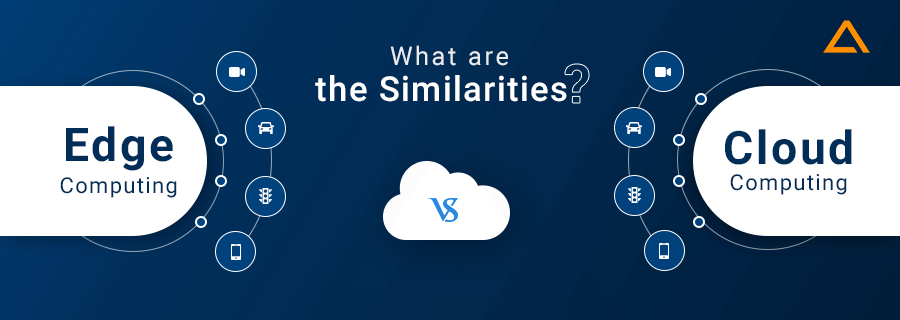
It is important to understand these similarities before moving on to the differences. Let’s dive right into it:
1. Future Ready Computing Solutions
Edge computing and Cloud computing vs on premise are better alternatives since they take off a load of maintaining physical servers and assets and their associated costs. Moreover, these two core technologies will likely be used together in the coming decade since they both provide impressive benefits and services.
For instance, autonomous vehicles are likely going to need edge computing as well as cloud computing. Since edge computing enables real-time data processing that is too close to the source, it becomes a more secure and reliable option instead of sending the processing request to a centralized server and waiting for a response since the slightest delay in doing so could result in fatal accidents or miscalculations. Edge computing can be referred to as an autonomous vehicle’s ‘eyes’ and ‘ears’.
However, autonomous vehicles can’t solely rely on edge computing since it doesn’t necessarily have the required processing power that matches cloud computing’s prowess. So, for carrying out other computationally heavy tasks such as enabling communication between two or more autonomous vehicles, updating traffic information and working with maps.
2. Unlocking Better Analytics
Cloud and Edge computing are capable and well-equipped for carrying out deep analytics for big data, science and other tasks. They can use some of the top analytical methodologies on huge structured, unstructured or semi-structured data chunks for deriving deeper insights by unlocking stronger analytics possibilities irrespective of their size or variations.
Companies can leverage the power of Edge and Cloud computing to understand market trends, analyze buying behaviours and gain a better insight into their customer’s behaviour and purchase habits. Using such information, they can formulate a more personalized and accurate advertising campaign to improve conversion ratios. They can also be used together for data science fields.
3. Ensuring Regulatory Compliance
One of the biggest hassles, especially when setting up your business overseas or on an international level, is understanding the various business compliances of different countries and taking corrective steps to abide by them. All organizations that use computing resources need to ensure they comply with any and all regulations relevant to their business. Cloud and edge computing can keep data in motion and data at rest encrypted. They also ensure all data are processed within the confinements of the mandated jurisdiction.
Wrapping Up!
Here is everything you need to know about Edge computing and Cloud Computing. Both these processes help solve different aspects of your computing requirement, and you may use either one or both in different combinations based on your project requirements.
have a unique app Idea?
Hire Certified Developers To Build Robust Feature, Rich App And Websites
Also Check:
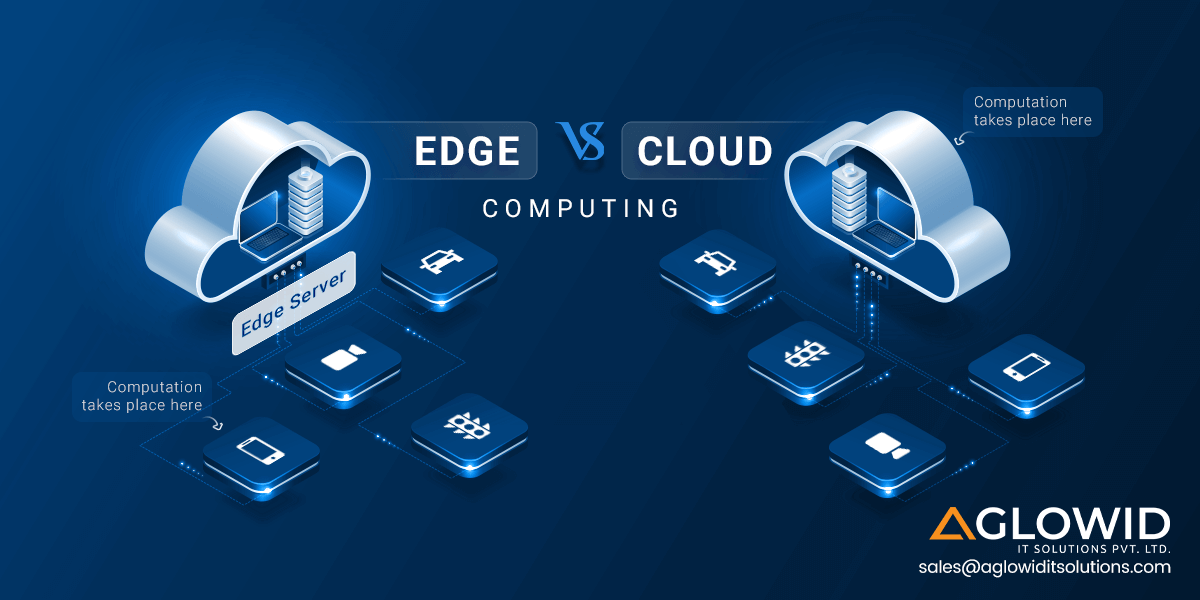

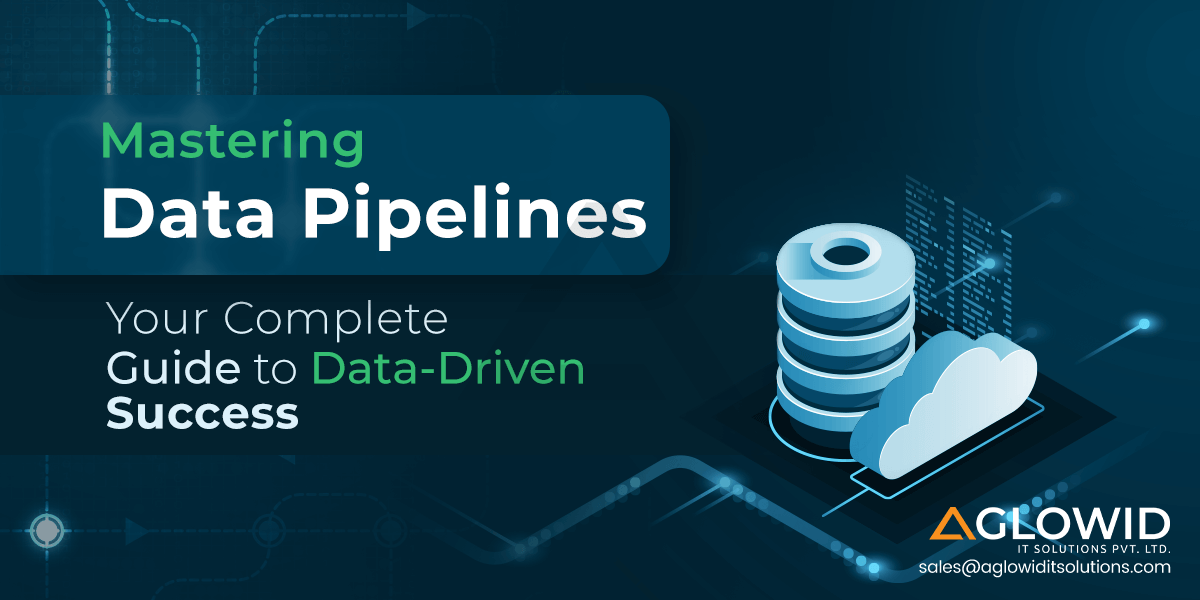
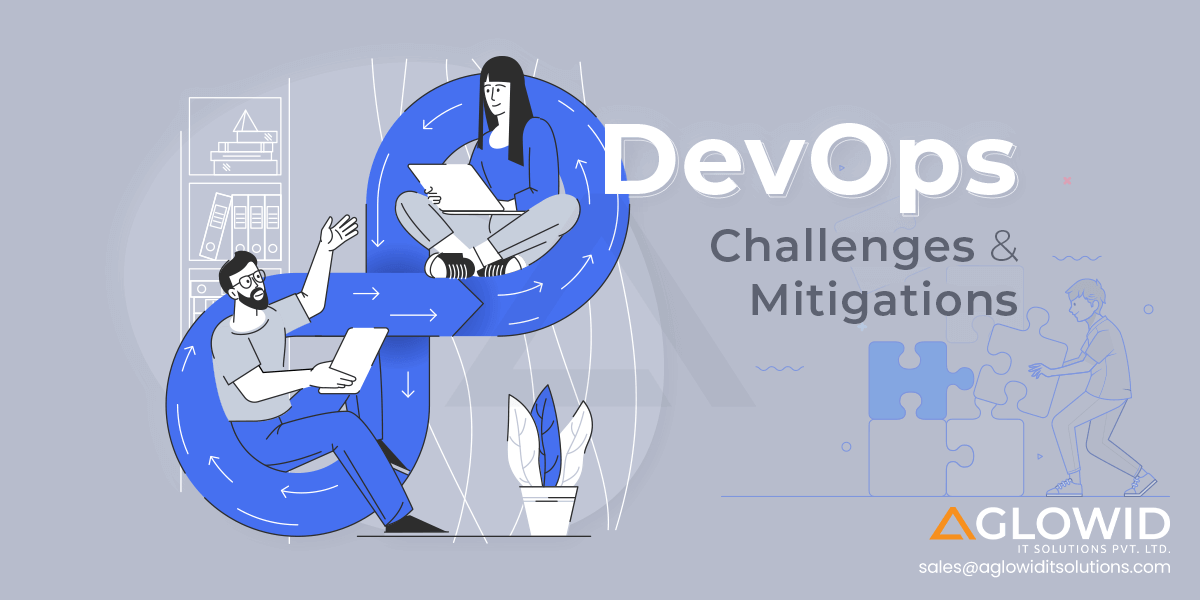

 Say
Say